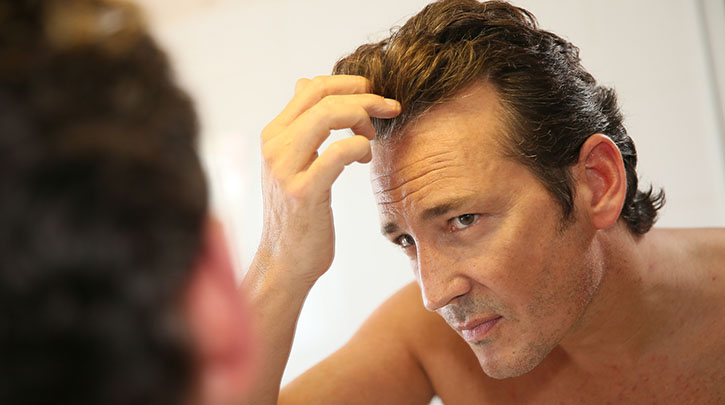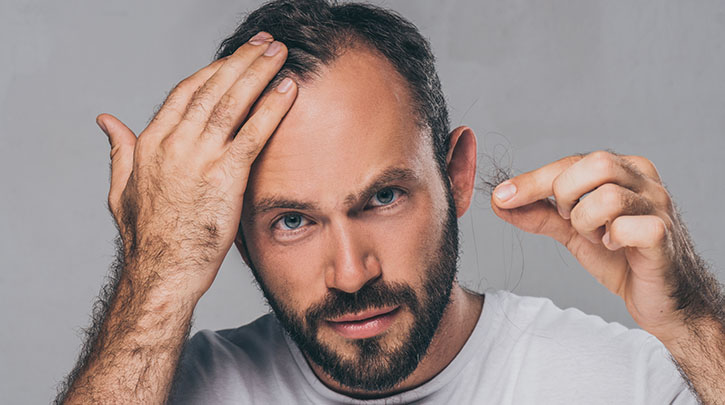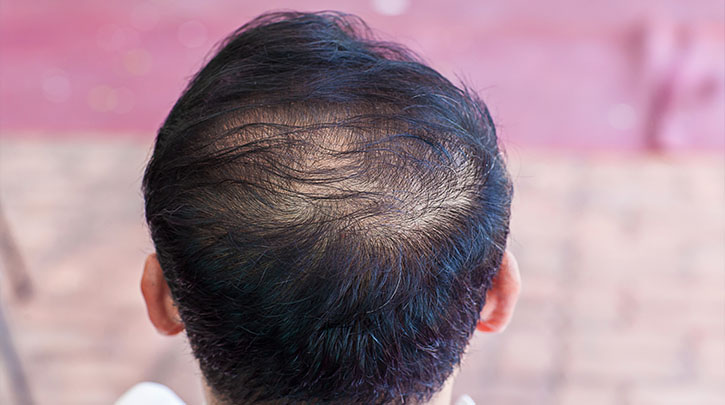
- Global
Get non-surgical solutions for today's top aesthetic concerns with Venus Treatments. Join thousands of satisfied patients worldwide!
- Loading...
- All Regions
Get non-surgical solutions for today's top aesthetic concerns with Venus Treatments. Join thousands of satisfied patients worldwide!

Hair. You groom it, dye it, cut it, style it, and spend a fortune on it throughout your life. It plays a major role in how you feel about your appearance and in the image you project to the world. A head full of healthy hair is associated with youth, attraction, and even wealth. Yet you may not realize how much importance it has for you until you start losing it.
Hair loss affects both men and women. As many as 30 million women in the US alone report experiencing some sort of hair loss. For men, the numbers are even higher, with 25% beginning to see signs of thinning before the age of 21 and around 85% with visible hair loss by age 50. Hair loss can manifest as a general reduction in the volume of hair follicles, which you may notice as an increase in strand buildup in the hairbrush, or if you notice more hair going down the drain when you shower. It can also be localized, showing up as balding spots on the scalp, or as a receding hairline or widow’s peak. If you’re concerned that you don’t seem to have as much hair as you used to, read on to learn about the causes and modern solutions for treating permanent hair loss.
Your susceptibility to hair thinning and balding, especially at an early age, is primarily genetic. However, even though we’ve all heard that male pattern baldness is passed down from the mother's father, there’s no true way to determine who’s going to inherit the “baldness gene.” What trichologists (hair experts) do know is that hair loss can be tied directly to a hormone called dihydrotestosterone, or DHT. For people with a higher sensitivity to DHT, the hormone causes hair follicle shrinkage, leading to weaker hair and eventually, less hair growth. DHT-related hair loss typically manifests as a receding hairline and the telltale bald spot at the crown of the head.
Beyond genetics, lifestyle factors can play a huge role in how long you can maintain a thick head of hair. Stress has been shown to trigger hair loss, so taking care of your mind and your physical wellbeing is important. For women, life events that cause major hormonal shifts, like pregnancy and menopause, contribute to thinning hair as well. Unlike with genetic causes, sometimes hair lost to external factors will grow back over time—but all too often, once the hair is gone, it’s gone for good.
If you have concerns about hair loss or hair thinning, it’s best to act now. You can speak to your doctor or dermatologist, but the best person to tell you whether your hair loss is permanent is a trichologist. They can do a full evaluation to determine whether your hair loss is genetic or due to lifestyle factors. Once they’ve discovered the cause, there is a range of solutions to promote hair growth in cases where the hair loss isn’t permanent. These could include dietary changes, topical treatments, supplements, or prescription medications.
In some cases, the appearance of thinning hair can be improved via lifestyle changes, over-the-counter products, or a change in your hair care regimen. Some medical therapies, such as the serum minoxidil or the pill Finasteride, have been in use for a long time and are known to be effective at improving the hair growth over time—but they come with serious side effects. For those with permanent hair loss, however, the treatments listed above may fall short or show no visible improvements at all. In this case, it’s time to consider the effective, long-lasting results of a medical aesthetic treatment.
Though hair loss is one of the most dreaded physical changes for both men and women, it doesn’t need to be. Thinning hair and balding can be treated quickly and effectively using new technologies that recapture what you’re missing most; the look of a full head of healthy hair. Hair restoration has come a long way since doctors started looking for a way to treat hair loss in the 1930s. Modern advancements in medical aesthetics for hair loss are already one of the most popular and sought-after treatments around, and they’re the second most-researched cosmetic treatment for men.
The hair restoration procedure in the highest demand for men and women concerned about lair loss is Follicular Unit Extraction (FUE). During an FUE session, the treatment provider extracts individual hair follicles from the back or sides of the head using a specialized device and then implants them in the area where more hair growth is desired. The newly implanted hair follicles continue the natural hair growth cycle and results improve each week, with full realization at 9-12 months post-procedure. Unlike previous methods, which involved surgically removing a strip from the back of the patient’s scalp and grafting it to a new area, FUE procedures are minimally invasive, enable a faster recovery process, and leave no linear scarring. Follicular Unit Extraction is the new gold standard in hair restoration because transplanting the hair follicles individually allows for a more natural-looking result, giving you back a full head of hair that you’ll be happy to see in the mirror every morning. Visit our before and after photo gallery to see for yourself just how amazing the results of this treatment can be.
Venus Concept treatments using our NeoGraft® or ARTAS® systems use state-of-the-art FUE technology to treat your permanent hair loss discreetly and successfully. Starting with deciding whether hair restoration is for you, our certified treatment providers are ready to walk you through every step of the process. To discover your customized solution for permanent hair loss, find a treatment provider near you by using the search field below:
Find a certified Venus Treatments provider near you today who specializes in today’s top aesthetic medical solutions.



Search below to find a provider near you and to learn about our non-surgical aesthetic treatments with ARTAS®, NeoGraft®, Venus Bliss™, Venus Blilss MAX™, Venus Versa™, Venus Legacy™ Venus Versa™ Pro, Venus Velocity™, Venus Viva™ MD, and Venus Glow™.
For more information call: (888) 907-0115 // [email protected] // 235 Yorkland Blvd., Suite 900, Toronto, ON, M2J 4Y8 Canada
REGULATORY CLEARANCES [ More ]
Venus Bliss™ is cleared by the FDA and licensed by Health Canada for non-invasive lipolysis of the abdomen and flanks in individuals with a Body Mass Index (BMI) of 30 or less, with the diode laser applicators. The (MP)2 applicator is cleared by the FDA for temporary reduction in the appearance of cellulite, and licensed by Health Canada for temporary increase of skin tightening, temporary circumferential reduction, and temporary cellulite reduction. Venus Bliss™ has CE Mark as a non-invasive medical aesthetic device enabling a comprehensive approach leading to body contouring, addressing fat reduction, skin tightening, circumference reduction, and cellulite reduction.
Venus Versa™ is cleared by the FDA, licensed by Health Canada, and has CE Mark as a multi-application device intended to be used in aesthetic and cosmetic procedures. The SR515 and SR580 applicators are cleared by the FDA, licensed by Health Canada, and have CE Mark for the treatment of benign pigmented epidermal and cutaneous lesions and treatment of benign cutaneous vascular lesions. The HR650/HR650XL and HR690/HR690XL applicators are cleared by the FDA, licensed by Health Canada, and have CE Mark for the removal of unwanted hair and to effect stable long-term or permanent hair reduction for Fitzpatrick skin types I-IV. The AC Dual applicator is cleared by the FDA, licensed by Health Canada, and has CE Mark for the treatment of acne vulgaris. The DiamondPolar™ and OctiPolar™ applicators on the Venus Versa™ system are cleared by the FDA for non-invasive treatment of moderate to severe facial wrinkles and rhytides on females with Fitzpatrick skin types I-IV. The DiamondPolar™ applicator is licensed by Health Canada and has CE Mark for non-invasive treatment of moderate to severe facial wrinkles and rhytides on females with Fitzpatrick skin types I-IV. The OctiPolar™ applicator on the Venus Versa™ system is licensed by Health Canada and has CE Mark for temporary body contouring via skin tightening, circumferential reduction, and cellulite reduction. The NanoFractional RF™ (Viva) applicator is cleared by the FDA, licensed by Health Canada, and has CE Mark for dermatological procedures requiring ablation and resurfacing of the skin.
NeoGraft® is cleared by the FDA, licensed by Health Canada and has CE Mark with indication for use in suction-assisted follicular extraction and re-implantation. It is an auto-graft system and can be used on both male and female patients.
ARTAS iX™ is cleared by the FDA, licensed by Health Canada and has CE Mark with indication for use for harvesting hair follicles from the scalp in men diagnosed with androgenic alopecia (male pattern hair loss) who have black or brown straight hair. ARTAS iX™ is intended to assist physicians in identifying and extracting hair follicular units from the scalp during hair transplantation; creating recipient sites; and implanting harvested hair follicles.
Venus Legacy™ is cleared by the FDA for the non-invasive treatment of moderate to severe facial wrinkles and rhytides in females with Fitzpatrick skin types I-IV with the OctiPolar™ and DiamondPolar™ applicators, and temporary reduction in the appearance of cellulite with the 4D Body (LB2) and 4D Face (LF2) applicators. It is licensed by Health Canada and has CE Mark for the temporary increase of skin tightening, temporary circumferential reduction, temporary cellulite reduction, and temporary wrinkle reduction.
Venus Velocity™ is cleared by the FDA, licensed by Health Canada and has CE Mark for hair removal, permanent hair reduction (defined as the long-term stable reduction in the number of hairs re-growing when measured at 6, 9 and 12 months after the completion of a treatment regimen), and the treatment of pseudofolliculitis barbae for all Fitzpatrick skin types.
Venus Fiore™ received regulatory approval in Israel for aesthetic and functional treatment of the vagina, labia and mons pubis. Venus Fiore™ is available for sale in India, Hong Kong, and other selected Asian countries.
Venus Viva™ is cleared by the FDA, licensed by Health Canada, and has CE Mark for dermatological procedures requiring ablation and resurfacing of the skin. The DiamondPolar™ applicator is cleared by the FDA, licensed by Health Canada and has CE Mark for the treatment of moderate to severe wrinkles and rhytides in Fitzpatrick skin types I-IV.
Venus Freeze Plus™ is cleared by the FDA for the non-invasive treatment of moderate to severe facial wrinkles and rhytides in females with Fitzpatrick skin types I-IV. It is licensed by Health Canada for temporary skin tightening, and temporary reduction in the appearance of cellulite on the abdomen and flanks, using the DiamondPolar™ and OctiPolar™ applicators. The DiamondPolar™ applicator on Venus Freeze Plus™ has CE Mark for the non-invasive treatment of moderate to severe facial wrinkles and rhytides, and the increase of skin tightening, temporary circumferential reduction, and cellulite reduction with the OctiPolar™ applicator.
Venus Heal™ is licensed by Health Canada and can be used for the treatment of both acute and chronic disorders of the musculoskeletal system, such as muscle spasms, back pain, and soft tissue injuries, and results in effects such as pain relief, myorelaxation, increase of local blood circulation, and edema reduction. In the U.S., Venus Heal™ is cleared by the FDA for the relief of minor muscle aches and pain, relief of muscle spasm, and temporary improvement of local blood circulation. These indications enable the treatment of certain soft tissue injuries and conditions.
Venus Glow™ is cleared by the FDA as a Class I motorized dermabrasion device. It provides a dermal rejuvenation treatment that works to open up and deep-clean pores. Venus Concept is the exclusive distributor for Venus Glow™.
Venus Epileve™ is licensed by Health Canada and has CE Mark for hair removal, permanent hair reduction (defined as the long-term stable reduction in the number of hairs re-growing when measured at 6, 9 and 12 months after the completion of a treatment regimen), and the treatment of pseudofolliculitis barbae for all Fitzpatrick skin types. Venus Epileve™ is also CE-Marked for hirsutism.
Venus Freeze™ is cleared by the FDA for the non-invasive treatment of moderate to severe facial wrinkles and rhytides in females with Fitzpatrick skin types I-IV. It is licensed by Health Canada for temporary skin tightening, and temporary reduction in the appearance of cellulite on the abdomen and flanks, using the DiamondPolar™ and OctiPolar™ applicators. The DiamondPolar™ applicator on Venus Freeze™ has CE Mark for the non-invasive treatment of moderate to severe facial wrinkles and rhytides, and the increase of skin tightening, temporary circumferential reduction, and cellulite reduction with the OctiPolar™ applicator.
Venus Swan™ is cleared by the FDA for the non-invasive treatment of moderate to severe facial wrinkles and rhytides, and licensed by Health Canada for the non-invasive treatment of cellulite reduction, skin tightening, and temporary reduction in the appearance of stretch marks.
Copyright © 2024 Venus Concept. All rights reserved.
You are entering our website. For other countries/regions and language options, please click the SELECT A DIFFERENT REGION button below.
SELECT A DIFFERENT REGIONAre you looking to get a treatment? Please visit our patient website to learn more.
Click HereUnsure which aesthetic treatment is right for you? Take this quick and easy quiz to discover treatments that suit your needs.
Get Started